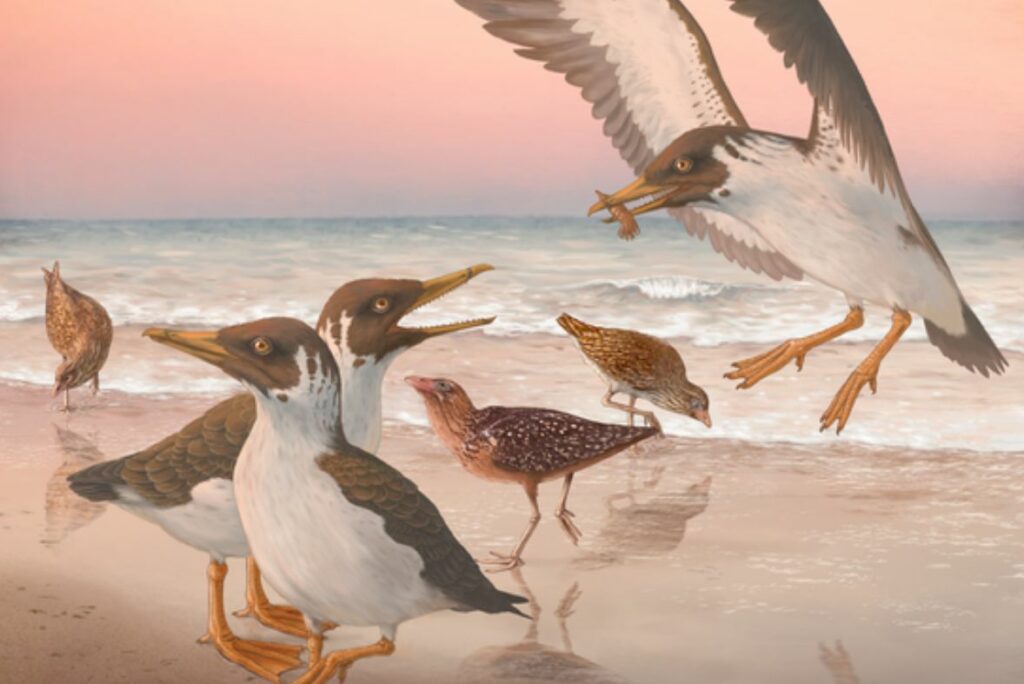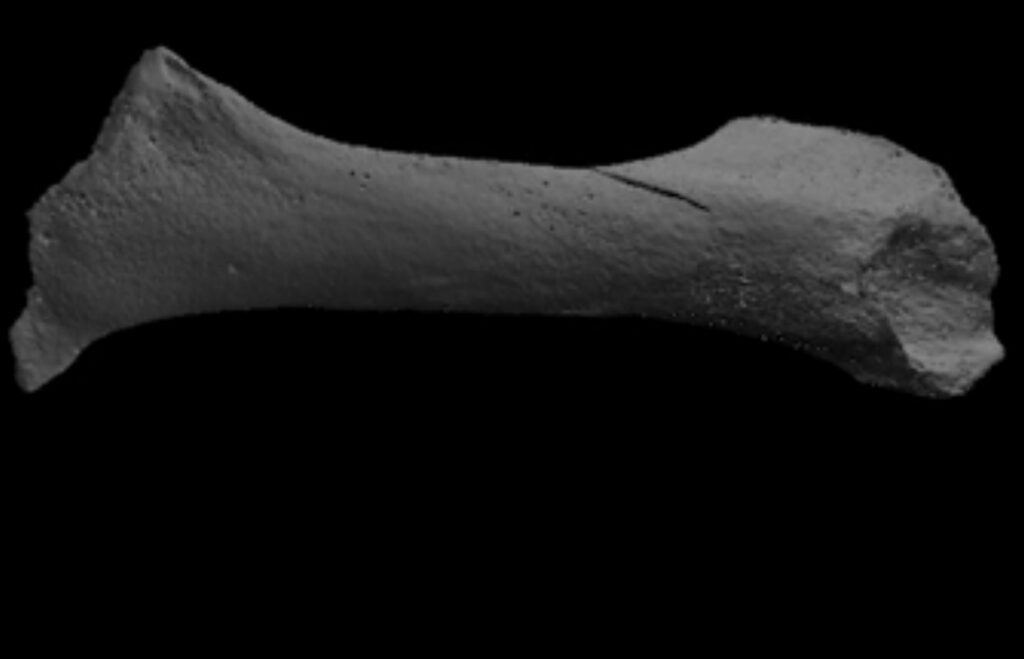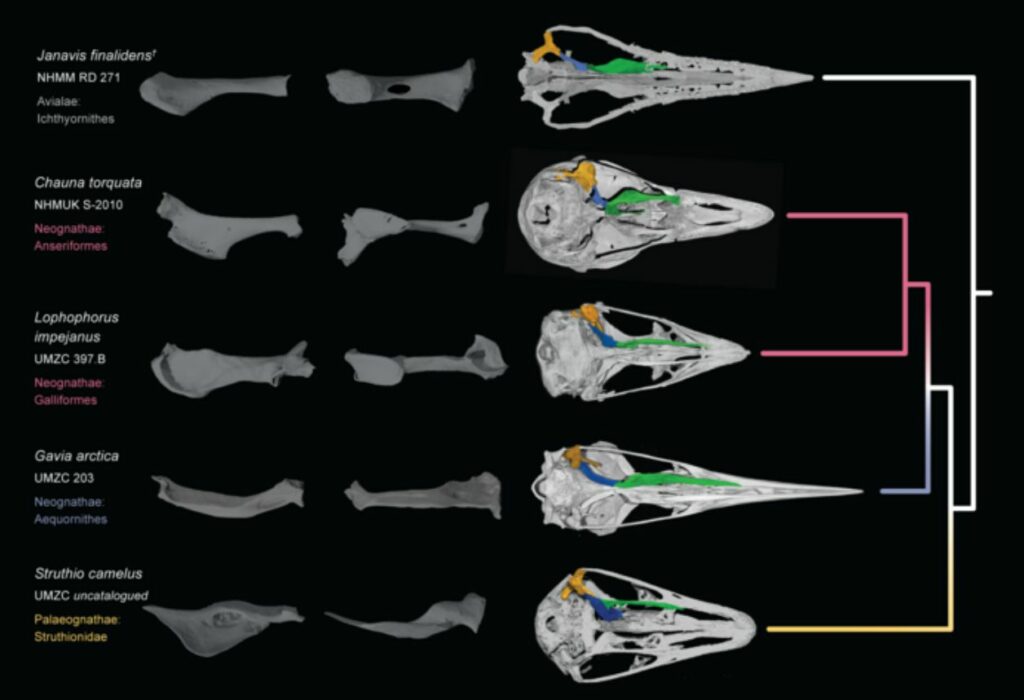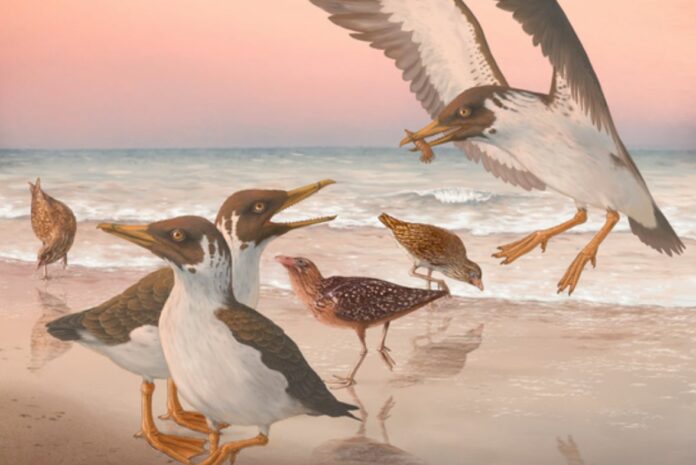The discovery of a new ‘dino-bird’ species dubbed Janavis Finalidens reported in the journal Nature today proves that “evolution doesn’t happen in a straight line”.
Fossilized skeletal remains discovered inside a grapefruit-sized rock have contributed to debunk one of the longest-held theories regarding the origins of modern birds.
One of the fundamental cranial traits that characterizes 99 percent of contemporary birds, a movable beak, originated before the great extinction event that wiped out all massive dinosaurs 66 million years ago, according to researchers from the University of Cambridge and the Natuurhistorisch Museum Maastricht.
This discovery shows that when modern birds originated, the skulls of ostriches, emus, and their cousins underwent “backward” evolution, returning to a more primordial state.
The researchers from Cambridge used CT scanning technology to identify bones from the palate, or roof of the mouth, of a new species of giant extinct bird they have dubbed Janavis finalidens.

It existed at the very end of the time period known as the Age of Dinosaurs and was one of the very last toothed birds to ever have inhabited the earth.
The way its palate bones were set up shows that this “dino-bird” had a flexible beak that was almost the same as that of most modern birds.
For more than a hundred years, people thought that the mechanism that lets a beak move happened after the dinosaurs died out.
But the new find, which was written about in the journal Nature, suggests that we need to rethink what we know about how the modern bird skull came to be.

About 11,000 different species of birds exist today, and they may be broadly divided into two categories depending on the structure of their palate bones.
The palaeognath, or “ancient jaw,” group includes ostriches, emus, and their cousins. This means that, like humans, the palate bones in these animals have fused together into a single mass.
All other bird species are categorized as belonging to the neognath, or “modern jaw,” group because of the movable joint that connects their palate bones.
Their beaks become considerably more agile as a result, making them useful for nest construction, grooming, food collection, and defense.
Thomas Huxley, a British scientist renowned as “Darwin’s Bulldog” for his outspoken defense of Charles Darwin’s theory of evolution, first distinguished the two categories.
He classified all extant birds in 1867 into two categories based on their jaws: “ancient” and “modern.” Huxley believed that contemporary birds originally had the ‘ancient’ jaw arrangement and that the ‘modern’ jaw developed later.

“This assumption has been taken as a given ever since,” adds senior author Dr. Daniel Field. “The main reason this assumption has lasted is that we haven’t had any well-preserved fossil bird palates from the period when modern birds originated.”
The Janavis fossil, discovered in a limestone quarry not far from the Belgian-Dutch border in the 1990s, had its first examination in 2002. It dates back 66.7 million years, to the end of the dinosaur era.
Scientists at the time could only describe the fossil based on what they could see from the outside since it is trapped in rock.
They identified the bone parts protruding from the rock as skull and shoulder bones and placed the nondescript fossil back in storage.
Nearly two decades later, the fossil was given to Field’s group at Cambridge, where Dr. Juan Benito, a PhD student at the time, began reexamining it.
“Since this fossil was first described, we’ve started using CT scanning on fossils, which enables us to see through the rock and view the entire fossil,” adds Benito. “We had high hopes for this fossil – it was originally said to have skull material, which isn’t often preserved, but we couldn’t see anything that looked like it came from a skull in our CT scans, so we gave up and put the fossil aside.”
Benito retrieved the fossil again in the very early stages of Covid-19’s confinement.
“The earlier descriptions of the fossil just didn’t make sense – there was a bone I was really puzzled by. I couldn’t see how what was first described as a shoulder bone could actually be a shoulder bone,” he adds.
“It was my first in-person interaction in months: Juan and I had a socially distanced outdoor meeting, and he passed the mystery fossil bone to me,” says Field. “I could see it wasn’t a shoulder bone, but there was something familiar about it.”
“Then we realised we’d seen a similar bone before, in a turkey skull,” adds Benito. “And because of the research we do at Cambridge, we happen to have things like turkey skulls in our lab, so we brought one out and the two bones were almost identical.”
The discovery that the bone was a skull bone and not a shoulder bone led the researchers to believe that the ‘modern jaw’ condition shared by turkeys originated before the ‘ancient jaw’ condition of ostriches and their relatives. For unexplained reasons, the fused palates of ostriches and relatives must have developed after the emergence of modern birds.
A toothless beak and a movable upper jaw are two of the major traits we use to distinguish contemporary birds from their dinosaur predecessors. Janavis finalidens was a pre-modern bird because it still had teeth, but its jaw structure is like that of a modern, mobile bird.
“Using geometric analyses, we were able to show that the shape of the fossil palate bone was extremely similar to those of living chickens and ducks” adds co-author Pei-Chen Kuo. Added co-author Klara Widrig:
“Surprisingly, the bird palate bones,” according to co-author Klara Widrig, “that are the least similar to that of Janavis are from ostriches and their kin.”
“Evolution doesn’t happen in a straight line,” adds Field. “This fossil shows that the mobile beak – a condition we had always thought post-dated the origin of modern birds, actually evolved before modern birds existed. We’ve been completely backwards in our assumptions of how the modern bird skull evolved for well over a century.”
While this result does not require a redrawing of the whole bird family tree, it does rewrite our knowledge of a crucial evolutionary trait of contemporary birds, according to the researchers.
And what happened to newly found Janavis?
It didn’t make it through the mass extinction at the end of the Cretaceous period, just like the big dinosaurs and other toothed birds.
According to the researchers, this may be due to its size: Janavis was around the size of a modern vulture and weighed about 1.5 kg.
Smaller creatures, such as the ‘wonderchicken,’ discovered by Field, Benito, and colleagues in 2020 and found in the same location as Janavis, had an advantage at this stage in Earth’s history since they needed to consume less to survive.
After the asteroid hit the Earth and destroyed global food supplies, this would have been advantageous.
Source: 10.1038/s41586-022-05445-y
Image Credit: Dr Juan Benito and Dr Daniel Field, University of Cambridge
